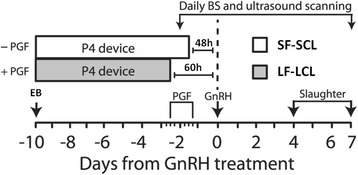Fig. 1.

Experimental model and hormonal treatments. Growth of the pre-ovulatory follicle (POF) of beef cows was programmed to generate two groups of cows, the large follicle-large CL group (LF-LCL; associated with greater receptivity to the embryo and greater fertility) and small follicle-small CL group (SF-SCL). To decrease exposure to P4 and thereby stimulate growth of the POF, animals from LF-LCL group received an injection of PGF at the moment of intravaginal P4-releasing device insertion vs. no injections in the animals from SF-SCL group. Also, removal of the P4-releasing device was 12 h earlier in the LF-LCL group. Follicle size, ovulation and CL size were accessed by ultrasound scanning of the ovaries. Blood samples were collected for P4 assay. Ovulation was induced by GnRH on D0. On D4 (Experiment 1) and D7 (Experiment 2) animal were slaughtered for samples collection. BS, blood sampling; GnRH, 1 μg of busereline acetate im; P4, P4 progesterone-releasing device containing 1 g of P4; +PGF, cows received 0.5 mg of sodium cloprostenol on D-10; -PGF, cows did not receive Cloprostenol on D-10; EB, 2 mg of estradiol benzoate; Slaughter, endpoint for endometrial tissue and uterine washings collection (Adapted from Reference 26)
